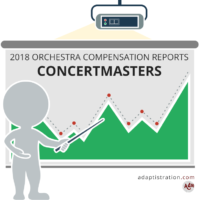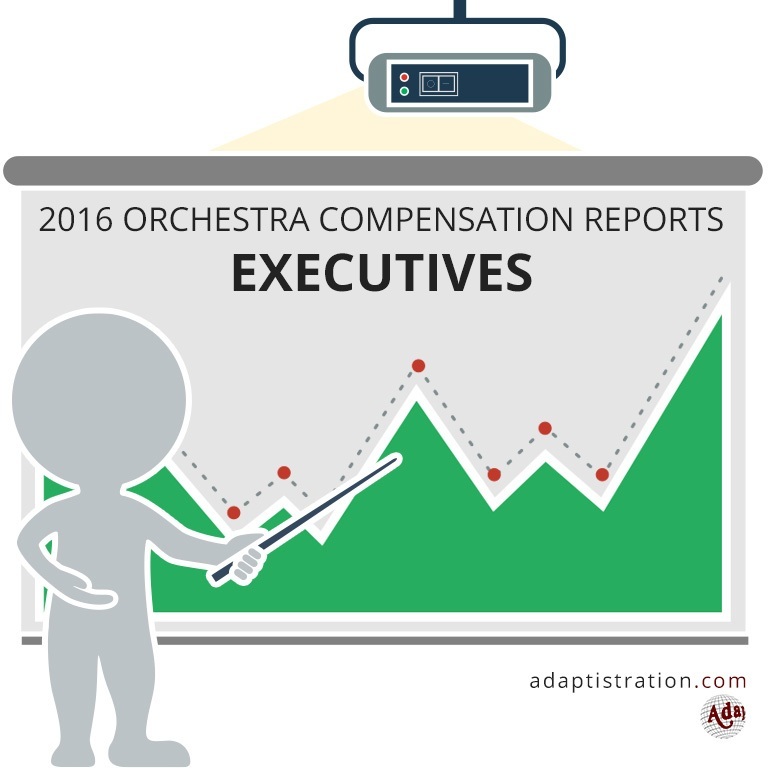After three consecutive years of decline, the 2015/16 season finally saw a positive gain in the average concertmaster’s compensation level. Nonetheless, overall growth over the last decade has been far below their music director and executive peers.
The Information
In order to provide information that is as accurate as possible, info from the 2015/16 season is gathered from the following source:
- Concertmaster compensation figures were obtained from their respective orchestra’s IRS Form 990 for the 2015/16 concert season.
Adaptistration makes no claim to the accuracy of information from documents compiled or reported by external sources. If you have reason to believe any of the information is inaccurate or has changed since reported in any of the above sources and you can provide documentation to such effect, please feel free to use the following form to submit a notice.
Did you know? Direct links to most of the orchestra’s financial disclosure documents at guidestar.org are available in the Orchestra Financial Reports.
An Important Note About Concertmaster Compensation Reporting
 Due to the changes in the IRS Form 990 several years ago, there are fewer concertmaster figures to report as compared to executives and music directors. Up until the 2008/09 season, nonprofit organizations were required to list a fixed number of employees who earned over $50,000/year, but the IRS increased that threshold to $100,000 for the 2008/09 season.
Due to the changes in the IRS Form 990 several years ago, there are fewer concertmaster figures to report as compared to executives and music directors. Up until the 2008/09 season, nonprofit organizations were required to list a fixed number of employees who earned over $50,000/year, but the IRS increased that threshold to $100,000 for the 2008/09 season.
Perhaps unsurprisingly, quite a few concertmasters earning more than $50,000 but less than $100,000 no longer appear on their respective orchestra’s Form 990.
As a result, concertmaster compensation figures tend to only appear for larger and mid budget size orchestras. Any orchestra in that grouping that does not report a concertmaster compensation is likely a sign that:
- their concertmaster position was unfilled for that season.
- the concertmaster earned over $100,000 but because didn’t earn enough to be included in the threshold of employees listed in the 990.
An unusual byproduct of the IRS reporting threshold modification in the 2008/09 season is average compensation values after that point are comparatively higher than before thanks to missing all of those sub $100k values. Consequently, it wouldn’t be unreasonable to expect that average compensation figures would increase following that season but as you can see in the following chart, those averages initially dropped then fluctuated between a series of increases and decreases.
Sorry, this information is no longer available.
* season where change to IRS reporting threshold was implemented.
Who Is This Concertmaster Person Anyway?
 For those not already familiar with the concertmaster position, this is the title reserved for the principal seat within the 1st violin section. More often than not, this is the musician you see walking out on stage at the beginning of the concert to initiate the orchestra’s tuning process before the conductor emerges.
For those not already familiar with the concertmaster position, this is the title reserved for the principal seat within the 1st violin section. More often than not, this is the musician you see walking out on stage at the beginning of the concert to initiate the orchestra’s tuning process before the conductor emerges.
Although concertmasters are included within every orchestra’s collective bargaining agreement, they also negotiate a mutually exclusive agreement with the orchestra detailing compensation and additional duties exclusive to that position. For example, it isn’t uncommon for a concertmaster to be featured as a soloist with the orchestra at least once a year. As such, their annual income will fluctuate based on the number of solo appearances and respective fees they negotiate with their organization.
Additionally, concertmasters are required to perform any of the numerous internal solos incorporated into any given piece of music (such as the famous violin solo from Scheherazade). Beyond actual performing duties, concertmasters (along with other principal seat string musicians) are usually required to perform additional duties such as bowings (which are markings placed throughout a string player’s sheet music that indicate which direction to move the bow. This allows each section of strings to move their bows in unison and enhance to the sense of phrasing a conductor wishes to use.
A common perk associated with many concertmaster individual contracts are clauses excluding them from having to perform during some non-masterwork oriented concerts (such as holiday, pops, or educational concerts). As this clause is not uniform, the frequency and type of concerts concertmasters are excluded from participating vary from one musician to the next. It is also one of the reasons why orchestras may have one or two additional violinists within the orchestra who serve under the title of associate or assistant concertmaster.
Regardless of the additional clauses a concertmaster negotiates in his/her personal contract, they are afforded the same base workplace protection and representation guaranteed all musicians under the organization’s collective bargaining agreement.
If you’re interested in learning more about a concertmaster’s duties and responsibilities, read It’s More Than Wearing Pretty Shoes by Chattanooga Symphony & Opera concertmaster Holly Mulcahy.
2015/16 Season Concertmaster Compensation
Sorry, but this information is only made available for one year until the following season’s reports are published. Copies are available for a fee (feel free to inquire), or you can begin compiling your own database by building a comprehensive library of orchestra 990s, available from the Adaptistration Store.
Top 10 Earners
- Cleveland Orchestra: $621,510
- San Francisco Symphony: $583,990
- Chicago Symphony: $539,900
- Los Angeles Philharmonic: $529,722
- Boston Symphony: $449,527
- Philadelphia Orchestra: $428,372
- National Symphony: $409,148
- Baltimore Symphony: $322,328
- Dallas Symphony: $293,027
- Cincinnati Symphony: $292,797
Items Of Interest
By and large, the 2015/16 didn’t hold any surprises, save one: the Cleveland Orchestra concertmaster’s return to the number one slot thanks to a 24 percent jump in compensation.
While spikes in that range aren’t unheard of, they typically happen during the final year of a concertmaster’s tenure.
But that wasn’t the case in Cleveland.
According to the orchestra’s 990, concertmaster William Preucil wasn’t paid anything above and beyond what his peer musicians earned with regard to retirement compensation, deferred compensation, and nontaxable benefits. The sharp uptick was related entirely to standard wage-based compensation.


